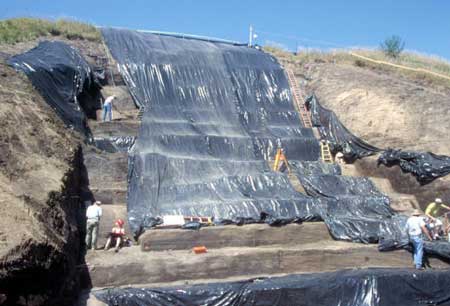Monks Mound was constructed as the symbolic center of Cahokia. At its peak, A.D. 1050 to 1100, Cahokia may have been home to as many as 15,000 people. Monks Mound is the largest earthwork In North America. Standing at 100 feet tall the earth and clay flat topped pyramid was constructed without wheels, metal tools or beast of burden. Previous research into the construction of the mound in the 1960’s determined that the mound was built in 14 stages and may have taken as long as 250 years.
However in 2005, the slopes of Monks Mound began to collapse, and Researchers took advantage of repairs being done to collect 22 soil samples from an exposed interior face of the mound. The sediments used to make the mound were studied, to determine how long the soil might have remained undisturbed. All indicators, the seeds present and the types, show that the soils in the burrow pits would not have remained undisturbed for long periods of time.
“If there was a substantial time lapse between the use of the borrow pits, we would have a different environmental profile — more well established perennials versus weedy annuals,” Dr. Schilling explained. “Consequently, we think activity in the borrow pits never ceased long enough for perennials to become established. Construction must have been relatively continuous without long interruptions.”
Rather it seems to indicate constant use of the Burrow pits located near the mounds. Uncarbonized seeds were also recovered, suggesting a very quick building process. Such uncarbonized seeds usually rot away when exposed to the elements, not lasting long in historic or archaeological sites. Usually only seeds that have been charred, by a fire, are recovered at open air archaeological sites.
They also discovered that blocks of sod were used in part of the construction, rather than just basket loads of earth, suggesting a quick and efficient building process
While cautioning that their research doesn’t provide “absolute ages” for the mound’s construction, Schilling noted that the “data do not contradict a very short chronology. In my opinion, 20 years is a good number,” Dr. Schilling said.
The microscopic clues turned up by their research may then lead to a new understanding of one of America’s most impressive prehistoric monuments, Schilling said. “At first glance, the mound fill sediments look like just dirt, but in reality we’ve added a considerable amount of knowledge to what the local Cahokia environment looked like while the mound was being constructed,” he said.
Learn more about Cahokia Mounds State Historic Site, and plan your visit.
Dr. Neal Lopinot, Missouri State University, and Dr. Timothy Schilling with colleagues Dr. Gayle Fritz and Dr. John Kelly of Washington University in St. Louis report their findings in the Midcontinental Journal of Archaeology.




